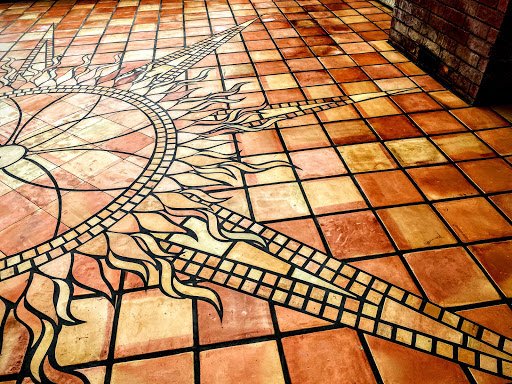J&R Tile has been installing tile and stone in San Antonio since 1984. In that time, we have seen every style, design, and material you can imagine. San Antonio, Texas, is a city rich in culture and history. The San Antonio tile scene is no different. From rustic saltillo tile to sleek modern porcelain tile, there is a tile option for every taste and style. Here are the most popular tile choices in San Antonio, Texas.
Installation by Artisan Tile, California
Saltillo Tile:
The most popular tile in San Antonio, Texas, is Saltillo tile. Saltillo tile is a type of clay tile that originates from Saltillo, Coahuila, Mexico. It has been used in homes and buildings for centuries, and its popularity has spread throughout the United States. Saltillo tile is a handmade, unglazed tile made from clay. It can be used on floors, walls, and even countertops. It is also an excellent choice for outdoor spaces like patios and porches because it can withstand extreme temperatures. It has a rustic, earthy look and is perfect for adding warmth and character to a home or business.
Saltillo tile is ideal for use in homes with a Spanish or Southwestern style. It is available in various shapes and sizes, including square, rectangular, hexagonal, octagonal, lantern-shaped, ect. The most common size of saltillo tile is 12x12 inches, but it can be customized to fit any space. When properly sealed, saltillo tile is easy to maintain and clean. However, it is essential to seal it regularly to prevent stains and damage. If you are considering adding saltillo tile to your home, choose a reputable installer and invest in proper maintenance to ensure its longevity. J&R specializes in installing, patching, and repairing Saltillo tile interior and exterior floors and walls.
Exterior Talavera Stair Risers with Saltillo Tile and trim
Talavera Tile:
Talavera tile is a type of Mexican pottery that features intricate designs and bright colors. These tiles are perfect for creating a vibrant and colorful space and are often used in kitchens and bathrooms. Its name comes from the Spanish town of Talavera de la Reina, where the techniques originated. Talavera tiles are made by hand, using a combination of clay and water, and then baked at high temperatures. The tiles are then painted with lead-free glazes and fired once again to create the vibrant colors and designs that are characteristic of Talavera tile. The tiles are often decorated with floral patterns, geometric shapes, and animal figures, and the colors used are bold and vibrant.
Talavera tile is also known for its high-quality craftsmanship and durability, making it a popular choice for both indoor and outdoor applications. Maintaining Talavera tile is relatively easy but requires some care to ensure its longevity. It is important to clean the tile regularly with a damp cloth and mild soap, avoiding abrasive cleaners that could damage the glaze. Talavera tile should also be sealed regularly to protect it from stains and moisture.
“Cuerda Seca” Ceramic Tile made by Carly Quinn Designs
Ceramic Tile:
Ceramic tile is a versatile and relatively durable tile that can be used in various settings, including bathrooms, kitchens, and entryways. It is available in many colors, patterns, and textures. Ceramic tile will likely be the best solution if you're on a tight budget. The price will be kinder on your bank account, and cheaper tiles don’t have to mean compromising on style. Ceramic tiles are available in various patterns and styles to suit any look. Ceramic tile is best used on walls and floors, home interiors, commercial interior walls, low-foot traffic areas, and indoors. Ceramic tile can be prone to cracking in cold weather - usually not a problem in San Antonio, but it is one of the reasons it is not recommended for external use by the manufacturers. We have, however, seen the glaze come off due to the years of extreme downtown heat with full sun exposure.
Porcelain Tile:
Porcelain tile is popular with homeowners and designers around San Antonio due to its durability, versatility, and aesthetic appeal. It is a ceramic tile made from a mixture of clays and minerals fired at high temperatures, resulting in a dense and durable tile. Porcelain tile is denser than ceramic and, therefore, less porous — meaning they're harder, more durable, and absorb less water.
Porcelain is resistant to scratches, stains, and moisture, making it an ideal choice for high-traffic areas such as showers, bathrooms, kitchens, and entryways.
Porcelain tile is also available in various colors, patterns, and textures. It can be designed to look and feel like natural stone or wood, making it a versatile option for any home decor style. Additionally, porcelain tile is easy to clean and maintain, requiring only regular sweeping and mopping to keep it looking its best. Porcelain is also a low-maintenance option for flooring, walls, and even countertops. Porcelain tile now comes in giant 5’x10’ sheets! (You will not see these products at the big box stores)
Unlike natural stone, which requires regular sealing, porcelain tile requires no special treatment to maintain its appearance. It can be easily cleaned with a damp mop or sponge and a mild detergent. J&R Tile is an industry leader in large-format, and up to 5’x10’ thin-gauged porcelain slab installation. We love this stuff!
Glass Mosaic Giant Beer Bottle Label - Altstadt Brewery, Fredericksburg. Designed and Installed by J&R Tile,
Mosaic Tile
Mosaic tile is defined by small tile, 4”x4” or smaller. These mosaic tiles can be made from porcelain, ceramic, stone, and glass. They can be used to slope to a drain in your shower, to creating a custom, one of a kind installation that can go anywhere, with any shape! Link to J&R Mosaic Ideas & Options
Typical colored 6”x6” red quarry on 1/4” grout joint
Quarry Tile
Quarry tile is a hard, impervious paving tile made from the ground minerals formed and fired in much the same way as is used to make brick. Quarry tiles are typically harder than ordinary clay bricks, due to the minerals used and the high firing temperatures. Unlike clay terracotta, quarry tiles are not porous and will resist water; and unlike ceramic tile and porcelain, quarry tile does not have a surface glaze layer.
Quarry tile is thicker than ceramic tile. Most quarry tiles are from 1/2-inch to 3/4-inch thick. But ceramic tiles are also found in thicknesses of between 3/8-inch to 5/8-inch, as are some ceramic tiles.
Quarry tile is durable, and can be found in residences and many commerical kitchens. J&R specializes in quarry tile repair work, and kitchen tile repair work!
Downtown San Antonio’s San Fernando Cathedral Courtyard, with 16”x24”x3/4” Travertine quarried from Mexico. Installation by J&R Tile
Travertine Tile
Travertine tile is a natural stone tile that has a unique, earthy look. It is often used in outdoor spaces, such as patios and pool decks, but can also be used indoors to create a rustic and natural look. Travertine has been used as a building material since ancient times. The Romans, in particular, were known for their extensive use of travertine in building structures such as the Colosseum and the Temple of Jupiter. One of the properties travertine is known for is its natural variation in color and pattern. The tile can range in color from light beige to dark brown, often featuring unique patterns and veining. Travertine is also a porous material, it requires sealing to prevent staining and moisture absorption. It is durable and can withstand heavy foot traffic, making it ideal for hallways and entryways. Travertine is also a popular choice for outdoor spaces such as patios and decks, as it is resistant to weathering and fading.
Travertine can be cut into many sizes and shapes, including square, rectangular, and irregular shapes. It can be used to create a multitude of design styles, from traditional to modern, and it can be polished or left in its natural state for a more rustic look. Travertine requires regular cleaning and maintenance to ensure its longevity. It should be swept or blown regularly to remove dirt and debris, and spills should be wiped immediately to prevent staining. Travertine tile should be sealed regularly to prevent moisture absorption and staining.
An installation photo of our team installing imported Italian Marble at Gucci, Located in Saks Fifth Ave at San Antonio’s North Star Mall.
Marble Tile
Marble tile is a naturally occurring, luxurious option often used in high-end homes and hotels. Its natural beauty, unique veining patterns, and color variations can add sophistication to any space. Marble tile applications include floors, bathrooms, kitchens, fireplace surrounds, and staircases. Marble is prone to staining and etching, so proper sealing and maintenance are essential to preserving its beauty.
Sealing: Marble is a porous material. Regular sealing is necessary to protect the surface from spills and other potential damage.
Cleaning: Use a gentle, pH-neutral cleaner to maintain marble tile surfaces. Avoid abrasive cleaners and acidic substances, which can damage the stone.
Spill management: Wipe up spills promptly to prevent staining and etching. Always use a soft cloth and blot gently rather than rubbing or scrubbing.
Regular maintenance: Schedule periodic professional polishing and resealing to maintain the luster and beauty of the marble.
Cement Tile
Cement tiles, also known as encaustic tiles, originated in the mid-19th century in France and quickly spread throughout Europe. They were inspired by ancient Roman mosaics and the intricate patterns of Islamic art. These handcrafted tiles were especially popular during the Art Nouveau and Art Deco periods and have continued to be a favorite among designers and homeowners alike.
The production of cement tiles is a labor-intensive process that requires the expertise of skilled artisans. Each tile is made by hand, using a blend of cement, sand, pigment, and water. The mixture is poured into a metal mold, which has been carefully designed to create the desired pattern. The mold is then pressed down, and the excess cement is removed. The tiles are left to dry for a few days and then cured with water for a couple of weeks to ensure their durability.
Cement tiles offer a timeless and versatile option for those looking to enhance their living spaces with unique, artisanal flair. By understanding their history, manufacturing process, benefits, and tips for selection, you can make an informed decision when choosing the perfect cement tiles for your home or commercial space. Embrace the beauty and charm of these handcrafted pieces.
San Antonio offers businesses, homeowners, and designers many tile options. Whether you prefer a rustic and earthy look or a sleek and modern design, there is a tile for every style and taste. If you have already purchased your tile, great! Contact J&R to get a quote for installation, and let us know what you selected.
If you are still looking to purchase your tile, J&R can help. We use our pricing to get you the best deal from the many tile retailers around San Antonio. We will handle the material order, pick up, and deliver it to your home or job site day of installation.
About J&R Tile
Winner of the 2022 National Tile Contractors Association Craftsperson of the year award — J&R Tile is a tile, stone, and paver specialist in San Antonio, Texas. The J&R team is a leader in historical tile restoration and is credentialed in ceramic, porcelain, natural stone, pedestal pavers, and glass tile installations for residential and commercial properties. Proudly serving San Antonio since 1984, contact us to schedule your free consultation and estimate.











